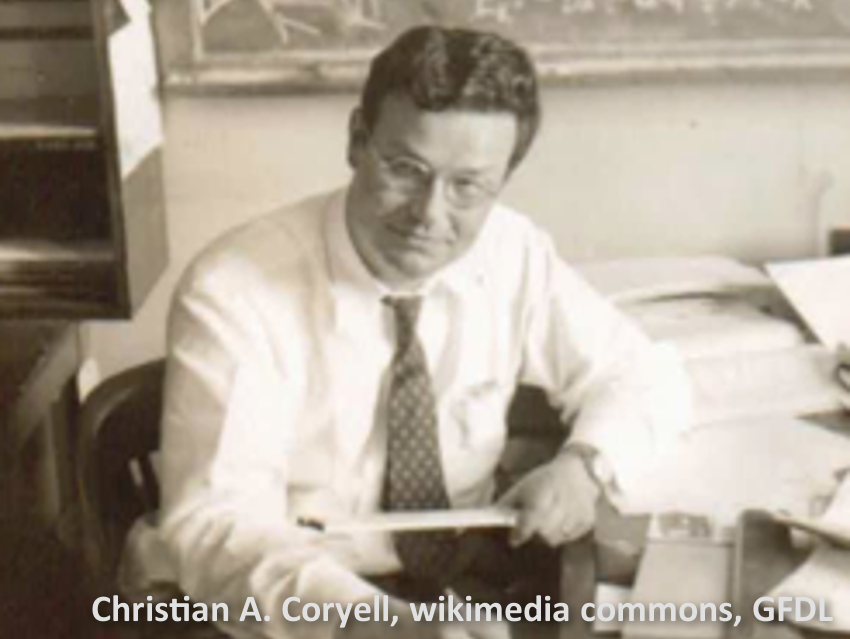Charles DuBois Coryell was born on February 21, 1912. He received his Ph.D. in chemistry from the California Institute of Technology (Caltech), Pasadena, USA, under the supervision of Arthur A. Noyes in 1935. After his Ph.D., he investigated the structure of hemoglobin, working as an assistant with Linus Pauling at Caltech. He then taught at the University of California, Los Angeles, USA, from 1938 to 1942.
In 1942, Coryell accepted a position in the Manhattan Project as Chief of the Fission Products Section, both at the University of Chicago, IL, USA, and at Clinton Laboratories (now Oak Ridge National Laboratory), Oak Ridge, TN, USA. His group worked on the characterization of radioactive isotopes created by the fission of uranium and on developing a process for the chemical separation of plutonium.
Coryell was one of the discoverers of the element promethium. Promethium is a radioactive element with the atomic number 61. It was first produced and characterized at Clinton Laboratories in 1945 by Coryell, Jacob A. Marinsky, and Lawrence E. Glendenin. The team announced their discovery in 1947 [1]. The element is named after Prometheus, a figure in Greek mythology who is considered a champion of humankind. He defied the gods by stealing fire from Mount Olympus and bringing it to humans. The name was suggested by Coryell’s wife, Grace Mary [2].
After World War II, Coryell joined the Massachusetts Institute of Technology (MIT), Cambridge, USA, as a faculty member working in inorganic chemistry and radiochemistry. His research was concerned with fission fine-structure and β-decay theory. Coryell remained at MIT until his death on January 7, 1971. Among other honors, he received a Louis Lipsky Fellowship from the Weizmann Institute of Science, Rehovot, Israel, and the Glenn T. Seaborg Award for Nuclear Chemistry from the American Chemical (ACS) in 1960. The Charles D. Coryell Award of the Division of Nuclear Chemistry and Technology of the ACS is named in his honor.
Charles D. Coryell is the answer to Guess the Chemist (109).
References
- [1] The Chemical Identification of Radioisotopes of Neodymium and of Element 61,
J. A. Marinsky, L. E. Glendenin, C. D. Coryell,
J. Am. Chem. Soc. 1947, 69, 2781–2785.
https://doi.org/10.1021/ja01203a059 - [2] Rediscovery of the elements: The Rare Earths–The Last Member,
J. L. Marshall, V. R. Marshall,
The Hexagon 2016, 4–9.
Sources
- Charles D. Coryell,
Atomic Heritage Foundation,
www.atomicheritage.org.
(accessed December 18, 2020) - Guide to the Charles D. Coryell Papers 1945–1959,
University of Chicago Library, 2006.
www.lib.uchicago.edu/.
(accessed December 18, 2020)
Selected Publications
- β-Decay Energetics,
C. D. Coryell,
Ann. Rev. Nucl. Sci. 1953, 2, 305–334.
https://doi.org/10.1146/annurev.ns.02.120153.001513 - Low-Energy Photofission Yields for U238,
H. G. Richter, C. D. Coryell,
Phys. Rev. 1954, 95, 1550–1553.
https://doi.org/10.1103/PhysRev.95.1550 - Search for Correlations of Most Probable Nuclear Charge ZP of Primary Fission Fragments with Composition and Excitation Energy,
C. D. Coryell, M. Kaplan, R. D. Fink,
Can.J. Chem. 1961, 39, 646–663.
https://doi.org/10.1139/v61-078 - A procedure for geochemical interpretation of terrestrial rare-earth abundance patterns,
C. D. Coryell, J. W. Chase, J. W. Winchester,
J. Geophys. Res. 1963, 68, 559–566.
https://doi.org/10.1029/JZ068i002p00559 - Ratios of Independent Yields of the Isomers Te131−131m and Te133−133m in Fission,
D. G. Sarantites, G. E. Gordon, C. D. Coryell,
Phys. Rev. 1965, 138, B353–B364.
https://doi.org/10.1103/PhysRev.138.B353 - Decay Schemes of 43-Day Cd115m and 2.3-Day Cd115g,
G. Graeffe, C. -W. Tang, C. D. Coryell, G. E. Gordon,
Phys. Rev. 1966, 149, 884–893.
https://doi.org/10.1103/PhysRev.149.884




